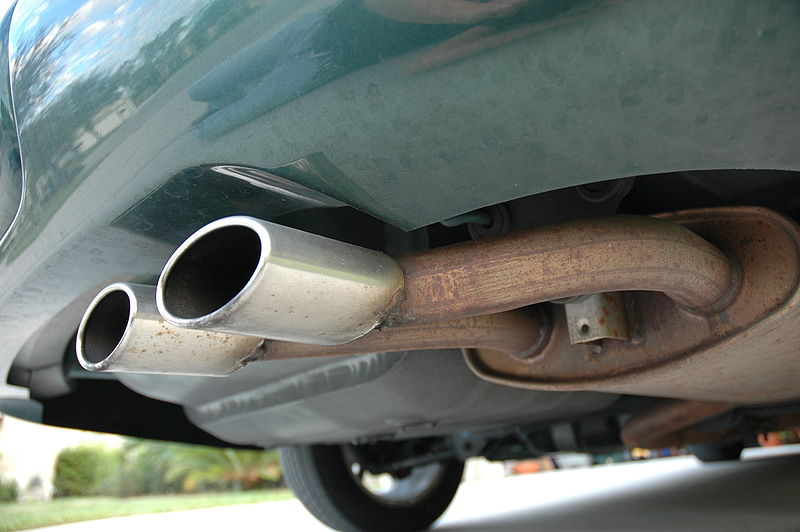The fight against smog has recently become a common topic in many countries. Therefore, if we see excessive smoke from the car’s exhaust pipe, we should not ignore it. It has a negative impact on the environment. Besides, it may indicate some defect in the catalyst, DPF filter or another element of the exhaust system, or even greater defects, including the engine. A badly diagnosed fault can cause unnecessary and over-the-top repair, which will cost us a lot.
Smoke from the exhaust pipe, diagnostics by color
The colour and smell of smoke often allow us to diagnose a problem. Therefore, anything that comes out of the vehicle’s exhaust pipe cannot be underestimated in excessive amounts.
Blue smoke from the exhaust pipe
One of the most characteristic is blue smoke. Many drivers are terrified at seeing such smoke from the exhaust pipe. Rightly, you should not underestimate the signal that the car gives. When it appears at the morning launch of a car, it suggests burning oil in naturally aspirated engines.
More exactly it indicates to the wear of the elastics/valve seals. The heated engine acts as a sealant, while the cold one causes the droplets of oil to flow into the cylinder, then the blown oil flows out the exhaust pipe. The occurrence of smoke during the increase of the engine’s rotation is usually nothing but destroyed rings. During the addition of gas, the pressure is very high. After some time, the piston may not maintain its tightness, and as a result, the oil will get into the combustion chamber.
Cars equipped with a turbocharger can also experience a blue smoke sign. This condition occurs in the event of a leak. The oil gets then by blowing it together with the air. In this case, it is difficult to determine whether it is a turbine defect or piston rings.

White smoke from the exhaust pipe
White smoke, in turn, does not always indicate any problem. If after starting the engine in the morning white smoke appears, it is possible that it is water vapour, odourless, transparent. Unfortunately, another strong white smoke from the exhaust pipe does not catch up. Then another element comes to the combustion process — water. The standard diagnosis, in this case, is the gasket under the head. However, it is not always set correctly. Car owners who have an EGR cooler (exhaust gas recirculation valve) should take this into account. You can perform a test on the content of exhaust gases in the cooling system. When it comes out positively, prepare for higher costs. It is not enough to just replace the gaskets and perform a number of other tasks like planning, assembly, new timing.
Black smoke from the exhaust pipe
Another one is black smoke, which does not surprise anyone and is mainly assigned to cars with a diesel engine. Very often this happens because driving around the city causes driving below the revolutions of the turbocharger activation. When the black smoke from the exhaust pipe is still emitted after the gas is added, it is the result of inaccurate fuel combustion, i.e. incomplete combustion.
Black fumes can also have a connection to the injection system. This is when faulty injectors or exhaust gas cleaning systems are involved. Vehicles with combustion engines that supply petrol less frequently, but may also experience black smoke. It is possible that the engine then gets too much oil. The key may be a catalytic converter or a DPF filter because they stop the amount of soot being excessive. You need to be aware of the situation that the oil burned in the combustion chamber is the result of the failure of the cylinder head or bottom. At that moment it is worth answering whether the repair will pay off. An important tip is also the use of the correct oil, a simple thing, but sometimes neglected.
The last thing that can be responsible for the emission of black smoke is chip tuning. What is that? It is an improvement of the engine parameters, through interfering with the computer software that controls its work. This is possible because car manufacturers often leave a good deal of stock in terms of parameter adjustment. After overclocking the parameters may damage components such as the crank — piston system, gearbox, turbocharger, clutch, injectors or driveshafts. Catalyst and particulate filter are also exposed. A higher increase in exhaust emissions is observed.
Grey smoke from the exhaust pipe
One more colour of exhaust gases is possible — grey. Most often appearing immediately after starting the engine. The cold engine is then in the so-called suction process. It supplies a rich mixture to the combustion cylinders. If this condition persists for a long time, the engine temperature sensor is most often to blame.
That is why it is important to know what the colours of the smoke from the exhaust pipe mean. Thanks to this, it is possible to save not only time to find the cause of the fault but also money.
